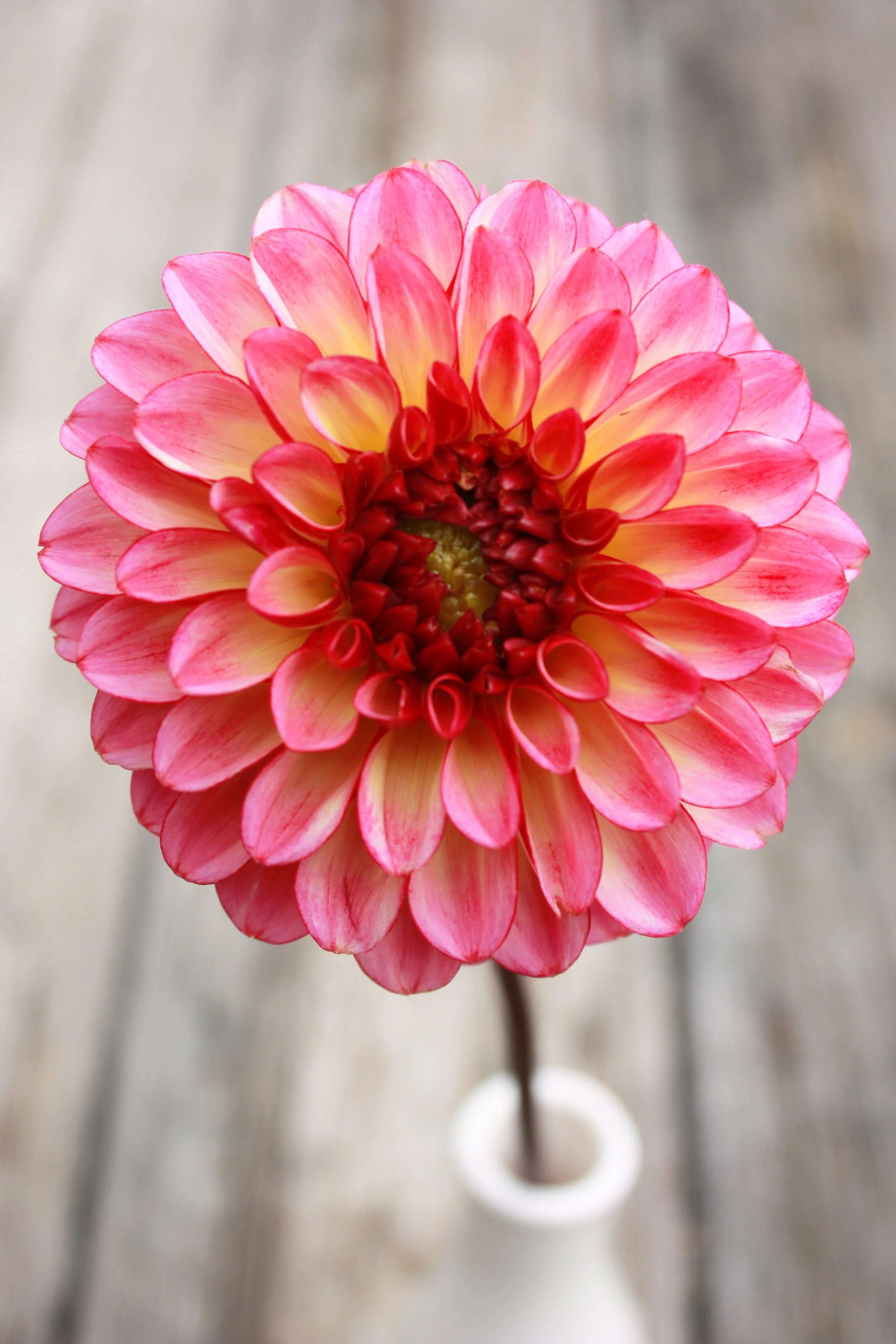GROWING DAHLIAS
Handpicked for you: Locally Grown dahlia tubers
dahlias grown right here in Traverse City. Each purchase supports two local businesses.
Our dahlias will look drastically different from the imported, dried-up clumps with broken necks you might be familiar with from the big box stores. These are beautiful, plump, individual tubers with intact necks, viable eyes and they’re ready to grow into the same variety the package promises.
TUBER BASICS
Tubers are packed in vermiculite, which is a natural mineral. It helps tubers from shriveling and drying out while they’re waiting to be planted. This is a friendlier alternative to the peat most tubers are packaged in.
Tubers should be firm and plump with intact necks. Each tuber contains at least one viable eye and will produce a full-sized, 3-4 foot tall plant. Tuber size doesn’t matter; with proper care a 2-inch tuber can produce the same size plant as 6-inch tuber. Until it’s time to plant, store your tubers in a cool, frost-free (40 - 50 degrees is ideal), dark environment.
PLANTING out
Plant out after risk of frost when soil temperatures are above 55 degrees. A good rule of thumb is when it’s warm enough to plant tomatoes, it’s safe to plant your dahlia tubers.
Choose a sunny, well-draining site, allowing enough room for plants to grow. Avoid wet or waterlogged soil, which can rot the tubers. Plant the tubers horizontally, about 2-3 inches deep and 12-18 inches apart, with the sprouting eye(s) facing up. If the eye isn’t sprouting yet, don’t panic. Plant the tuber and the sprout will find its way. Avoid watering until you start to see sprouts break through the soil.
Tubers can be planted out through the beginning of July and, because dahlias are late bloomers, they will have enough time to bloom and produce tubers.
GROWING in containers
Alternatively, you can give your tubers a head start in containers, or grow them in large large pots if you don’t have any garden space. Simply choose an appropriate sized container to accommodate the tuber and follow the same instructions as you would if you were planting the tuber directly in the ground.
If you’re plan on growing the dahlias in the ground after sprouting them, choose a container just large enough to fit the tuber. If you plan on growing the dahlias in a container, choose at lease a 5-7 gallon pot with good drainage.
Growing on
For a bushier plant and to encourage more flowering stems, pinch out the main growing stem when the plant has 3 sets of leaves. This will encourage side branches (and more flowers!) to develop.
If you live in a windy area, you might want to stake or corral your dahlias. Tomato cages or peony supports work well. Insert them into the ground early to avoid damage to your tubers.
Once they start growing, dahlias are thirsty plants and need frequent and regular watering. They also appreciate feedings of a balanced fertilizer throughout the season.
To encourage plants to continue flowering, deadhead regularly.
cutting flowers
Don’t be afraid to cut deeply into the plant for a long stem. It’ll encourage the flowers that follow to grow nice, long stems.
Cut dahlia flowers when they are about half to three-quarters open. Cut them early in the morning or later in cool of the evening using clean, sharp pruners. Place them in water immediately. Use an impeccably clean vase, and change water regularly. Re-trim stems every other day.
Keep flowers cool and out of direct sunlight. Growing plants need the sun. Cut flowers don’t! Also keep flowers away from fruits and vegetables. They emit ethylene, which can prematurely age and wilt the flowers.
end of season
Dahlias will continue to flower long after other flowers have pestered out, making them a great addition to your garden and landscape. Unfortunately they aren’t hardy in our climate.
They will pump out blooms right up until the first hard frost of fall, which will turn the plants into a melting, black mess. Have heart! This is the beginning of the process of saving your own tubers for next year!
Cut back the dead foliage, wait a week or two to allow the tubers in the ground to cure, and carefully lift your clump of tubers. That’s right! You’ll find your single dahlia tuber has grown into a clump of several tubers!
Need more resources?
Want to learn more? Check out some favorite dahlia resources below to scratch that need-to-know-everything-about-dahlias itch:
Consider joining the West Michigan Dahlia Society to connect with other enthusiasts and growers.
From Summer Dreams Dahlia Farm, The definitive guide to splitting dahlia tubers
Also from Summer Dreams Dahlia Farm, a comprehensive guide to growing dahlias
Floret’s guide on how to grow dahlias. Floret also has a beautiful hardcover book called Discovering Dahlias.
Are you a more experienced gardener? Want to learn how to multiply your collection by taking dahlia cuttings? Check out this guide from Love n’ Fresh Flowers.
Search for dahlia varieties and suppliers with Dahlia Addict














